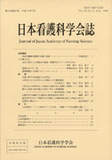Japanese
English
- 販売していません
- Abstract 文献概要
- 参考文献 Reference
- サイト内被引用 Cited by
要旨
本研究は,看護学生が臨床実習中に看護上の判断に困難を感じる場面において,臨床状況の理解や対処を助ける指導者の働きかけを明らかにすることを目的とした.看護大学生12名を対象に,実習終了後に半構成的面接を行った.得られたデータを指導者の働きかけと学生の反応に焦点を当て分析した結果,以下のことが明らかになった.
看護上の判断に困難を感じる場面は患者への接し方,看護のあり方,患者との関係の築き方に分類された.判断困難の状況の理解や対処の可能性が広がる働きかけとして学生の考えや経験を支持する,状況を洞察することを助ける,看護の進め方の判断材料を提供することが,助けとならない働きかけとして学生の考えを尊重しない,アドバイスがない,結論のみを指示することが抽出された.
看護上の判断困難のタイプと働きかけの特徴をみると,患者への接し方では状況を洞察することを助けることが,看護のあり方では看護の進め方の判断材料を提供する,学生の考えや経験を支持することが,また患者との関係の築き方では状況を洞察することを助ける,看護の進め方の判断材料を提供する働きかけが重要であった.
指導者が学生の判断困難のタイプを見極め,学生の主体性を尊重しながら適切な働きかけを使い分ける必要性が結果より示唆された.
Abstract
The purpose of this study was to explore helpful teaching approaches when students faced difficulties in nursing judgment during clinical practicum. Twelve baccalaureate students were interviewed using open-ended questions after clinical practicum in adult nursing. Data was transcribed and each episode was coded according to the teaching approaches and students' responses.
Findings indicated that there were three types of difficulties in nursing judgment, 1) understanding patients' responses and how to cope with them, 2) decision-making in nursing care, and 3) the interaction with a patient who is difficult to communicate with, Three categories of teaching approaches which helped students understand the clinical situations and cope with them were identified, 1) supporting the student's ideas and experience, 2) assisting the student in recognizing the patient's situation, 3) presenting various perspectives. On the other hand inappropriate teaching approaches were seen. These were: 1) not listening to student's ideas, 2) giving no advice and 3) giving answers without explanations. There were also sub categories associated with these teaching approaches. The relationship between the types of difficulty and teaching approaches were identified. “Assisting the student in recognizing the patient's situation” was helpful in overcoming “difficulty in understanding patients' responses and how to cope with them.” “Presenting various perspectives” and “supporting the student's ideas and experience” effectively overcame “difficulty in making decision in nursing care.” To cope with “difficulty in interacting with a patient who is difficult to communicate with,” “Assisting the student in recognizing the patient's situation” and “presenting various perspectives” were more important.
In helpful cases clinical instructors approached the case so that students could establish their independence. These results suggest that clinical instructors should assess the type of the student's difficulty in nursing judgment and choose the appropriate teaching approaches to assist them.
Copyright © 1999, Japan Academy of Nursing Science. All rights reserved.


